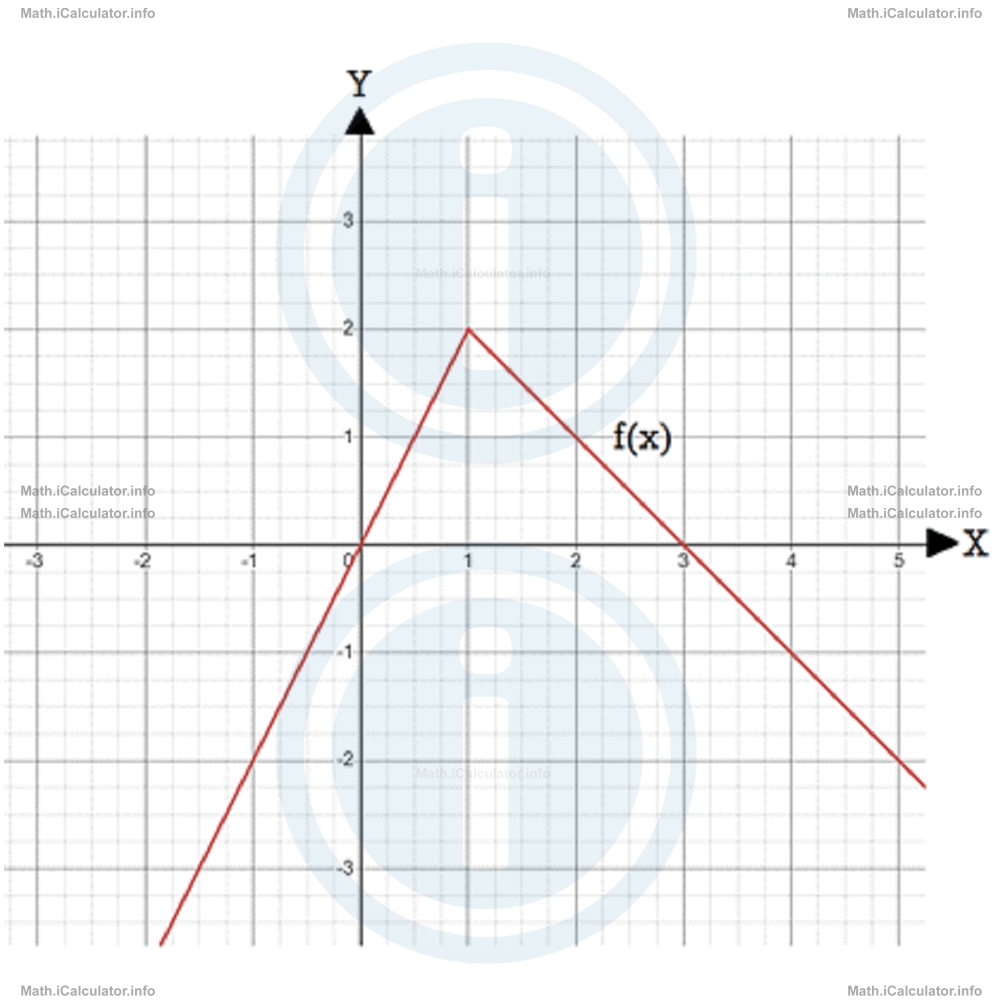Menu
Math Lesson 16.5.1 - The Meaning of Piecewise Functions
Please provide a rating, it takes seconds and helps us to keep this resource free for all to use
Welcome to our Math lesson on The Meaning of Piecewise Functions, this is the first lesson of our suite of math lessons covering the topic of Piecewise Functions, you can find links to the other lessons within this tutorial and access additional Math learning resources below this lesson.
The Meaning of Piecewise Functions
Look at the graph below.

It is clear that the graph represents a function because every x-value has in correspondence a single y-value (you can make the vertical line test to convince yourself about this fact). However, the graph does not represent any of the known functions discussed so far. We can see that this is a kind of composite function consisting of two different parts, where each part represents a linear function. These linear functions have different gradients and therefore different formulas. Thus, using the known techniques, it is easy to see that the left part (up to x = 1) represents the graph of the linear function f(x) = 2x while the right part (from x = 1 and onwards) represents the graph of the linear function f(x) = 3 - x. When combined (such as in this case), they give a single composite function where both individual functions must appear separately. We call this new function a piecewise function and express it as follows
The point x = 1 is called a limit point. It shows the horizontal coordinate in which the first function ends and the second function begins. We assumed arbitrarily that only the second function includes this point; however, if this fact is not explicitly clarified, the reverse can also be true, i.e. the function shown in the figure could also be
By definition, a piecewise-defined function is a special type of function that is described not by a single equation, but by two or more ones.
The general structure of a piecewise function obtained by two equations is shown below.
For example,
is a piecewise function, as it contains two different equations (3 - x and 2x + 1) in two different parts of the domain (x ≤ 0 and x > 0).
The two (or more) components of a piecewise function are analysed separately in their corresponding part of the domain. This action also includes plotting the graph for each part separately.
When we are asked to find the value of a piecewise function at a given point, we consider only the equation that corresponds to the part of the domain this point belongs. Let's explain this through an example.
Example 1
The piecewise function
is given. Find:
- f(-2)
- f(3)
- f(0)
Solution 1
- We must consider the bottom part of the function for calculating f(-2), as for x < 0 all values belong to this part of the function. We have f(x) = 2x - 1
f(-2) = 2 ∙ (-2) - 1
f(-2) = -4 - 1
f(-2) = -5 - We must consider the top part of the function for calculating f(3), as for x > 0 all values belong to this part of the function. We have f(x) = x2
f(3) = 32
f(3) = 9 - The number 0 in the domain belongs to the first function. Therefore, we have f(x) = x2
f(0) = 02
f(0) = 0
You have reached the end of Math lesson 16.5.1 The Meaning of Piecewise Functions. There are 6 lessons in this physics tutorial covering Piecewise Functions, you can access all the lessons from this tutorial below.
More Piecewise Functions Lessons and Learning Resources
Whats next?
Enjoy the "The Meaning of Piecewise Functions" math lesson? People who liked the "Piecewise Functions lesson found the following resources useful:
- Definition Feedback. Helps other - Leave a rating for this definition (see below)
- Functions Math tutorial: Piecewise Functions. Read the Piecewise Functions math tutorial and build your math knowledge of Functions
- Functions Revision Notes: Piecewise Functions. Print the notes so you can revise the key points covered in the math tutorial for Piecewise Functions
- Functions Practice Questions: Piecewise Functions. Test and improve your knowledge of Piecewise Functions with example questins and answers
- Check your calculations for Functions questions with our excellent Functions calculators which contain full equations and calculations clearly displayed line by line. See the Functions Calculators by iCalculator™ below.
- Continuing learning functions - read our next math tutorial: Inverse Functions
Help others Learning Math just like you
Please provide a rating, it takes seconds and helps us to keep this resource free for all to use
We hope you found this Math tutorial "Piecewise Functions" useful. If you did it would be great if you could spare the time to rate this math tutorial (simply click on the number of stars that match your assessment of this math learning aide) and/or share on social media, this helps us identify popular tutorials and calculators and expand our free learning resources to support our users around the world have free access to expand their knowledge of math and other disciplines.